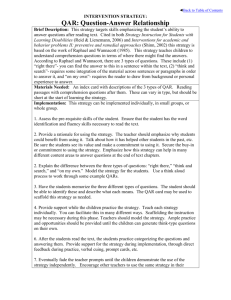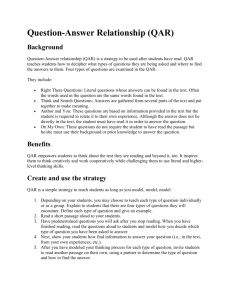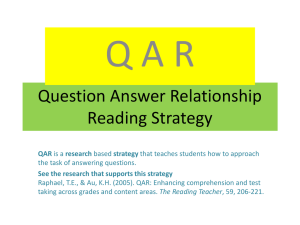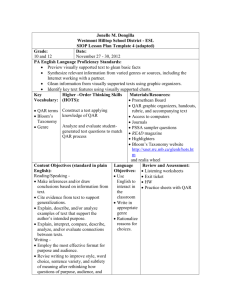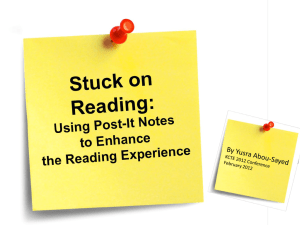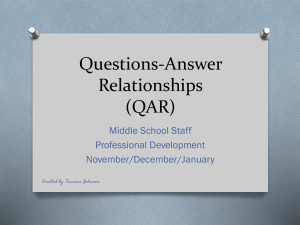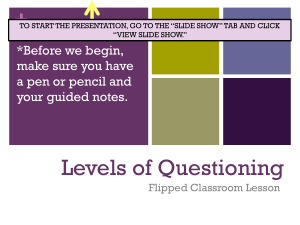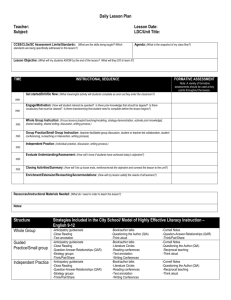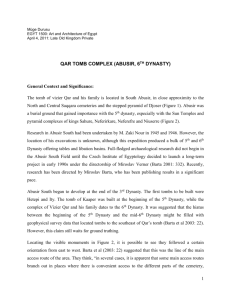Development of Materials PowerPoint
advertisement
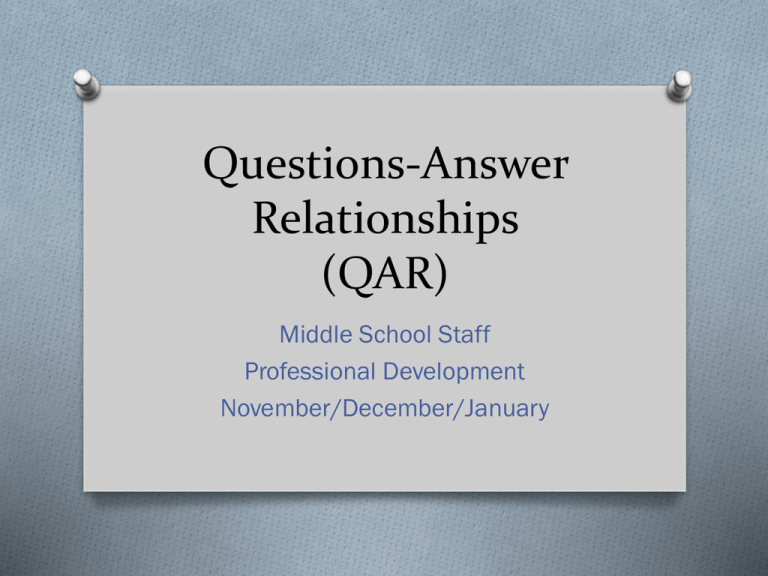
Questions-Answer Relationships (QAR) Middle School Staff Professional Development November/December/January ANTICPATE! O Please complete your anticipation guide for Question-answer relationships. O Refer to your anticipation guide throughout the presentation. O You will return to it at the end of the presentation. Questions-Answer Relationships QAR What is it? Questions-Answer Relationships O Purpose O The QAR strategy is a reading comprehension strategy developed to clarify “how students approach the tasks of reading text and answering questions (Raphael, 1986). O The QAR strategy shows students that questions and answers have a variety of sources, and that learning about questions and their answers will help them as readers to become better at understanding and answering questions (Iowa Department of Education, 2004). Questions-Answer Relationships O Rationale O QAR encourages students to be active, strategic readers of texts (Raphael, 1986). O QAR gives students a language for talking about the strategies they use to answer questions (Iowa Department of Education, 2004) O QAR helps students develop an awareness of their own cognitive processes when answering questions (2004). Minute Reflection O Take a minute to think about…What is the purpose and rationale of using QAR? O Share Questions-Answer Relationships O Four categories of questions are studies during strategy use and practice. Questions-Answer Relationships: Text-based QAR’s O “Right There” O The answer is in one sentence of the text. O The question and answer usually have the same wording. O There is usually only one right answer to Right There questions O Who is… O Where is… O How many… O What is… O When did… Questions-Answer Relationships: Text-based QAR’s O “Think and Search” O The answer is found in several parts of the text. O The question and answer have different wordings. O Answers are usually short answers O For what reason…? O How did…? O Why was…? O What caused…? O Summarize… O Compare/contrast… Questions-Answer Relationships: Knowledge-based QAR’s O “Author and Me” O The answer to the question comes from both clues in the text and student prior knowledge. O Students must synthesize the text to fully understand the question. O Would you…? O Which character…? O Did you agree…? O What did you think of…? Questions-Answer Relationships: Knowledge-based QAR’s O “On My Own” O The answers come entirely from the students’ prior knowledge. O These questions require inferential and evaluative thinking. O Answers to not require information from the text, but do require that students make some type of judgment about or relate to the topic. O Do you know…? O Have you ever…? O Would you ever…? Four Categories: Practice! With your neighbor, identify the type of question. O Jerry picked up his bat and ball. He loved those sunny Saturday afternoons. Before he left the house, he remembered to grab his glove from the bin. He ran the two blocks. Some boys were already there hitting and catching fly balls. Jerry joined right in, deciding to get in some extra practice while waiting for the coach to show up. O What did Jerry take with O O O O O O him? Where was Jerry’s glove? Where did Jerry go? Why does Jerry love sunny Saturdays? What is Jerry’s favorite game? What is your favorite game? Is it a good idea for kids to play baseball? Minute Reflection O Take a minute to think about…what are the differences between what students are asked to do with text-based QAR’s and knowledge-based QAR’s? O Share How do you use QAR O Gradual Release of Responsibility O Begin by teaching students necessary vocabulary O Model the four types of questions O Guide students by having them identify different types of questions then answer them correctly O Have students practice writing and labeling different types of questions followed by the correct answers (Raphael, 1986). When do you use QAR O In any situation where students interact with nonfiction, as well as fiction text O Reading/English/Lan O O O O guage Arts Writing Math Social Studies Science Why use QAR O QAR is a research based reading strategy that benefits every type and level of learner. O QAR helps students comprehend more of what they have read and learn that all answers may not come from the text. O QAR easily and authentically embeds itself into every content area. Questions-Answer Relationships: Cooperative Learning Activity O Directions: With your group, brainstorm a list of various settings and situations you can use QAR with during the rest of the school year. Questions-Answer Relationships O Please refer back to your anticipation guide. O Make any necessary changes and corrections. Questions-Answer Relationships O Questions? O Concerns?

